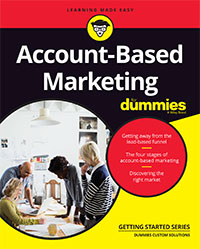Account-Based Marketing For Dummies
Download E-BookThe best part about ABM is that it works. ABM inverts the traditional marketing funnel where you fill the top of the funnel with lots of contacts which are then weeded out as they advance through the various stages of the journey. Rather than casting the net far and wide with ABM, the goal is to use a spear to catch the best fish for your business. According to Gartner (2021), by the end of 2020, more than 70% of B2B marketers at medium to large organizations will implement ABM in some capacity. Further, organizations with ABM initiatives see "higher win rates, faster sales cycles, and increased deal size."
The concept of ABM is not new, but today's technology platforms are making it possible to target high-probability prospects with customized communications more effectively than ever before.
In traditional marketing, when a lead is handed off to sales, the marketing team's engagement ends. In ABM, though, ongoing engagement between sales and marketing continues to create personalized campaigns and touch points across multiple channels. This is critical because, over time, targeting tactics must evolve based on feedback from sales teams' customer interactions.
Why is ABM so important to your overall marketing strategy? Because generating quality leads is difficult and expensive! In fact, immediately after training marketing talent, developing traffic and leads is reported as the second most significant challenge facing marketers (HubSpot, 2022). Over the past decade, inbound marketing has helped reduce the reliance on costly push marketing tactics. However, despite those successes, salespeople still report that only 5 percent of the leads they receive from marketing activities are high quality (State of Inbound Marketing Trends, 2022).
ABM can look different from organization to organization, and that's because there are several approaches is no settled definition. ITSMA (2017), for example, segments ABM into three types, one-to-one or strategic ABM, one-to-few or lite ABM, and one-to-many or programmatic ABM. Strategic ABM is usually reserved for an organization's most valuable customers or prospects because it requires a deep understanding of the business and close relationships with the customer. Lite ABM is generally applied to groups of mid-tier accounts that share similar attributes and business needs. Finally, programmatic ABM has only recently become practical through technology. With programmatic ABM, a single marketer could work across hundreds or thousands of identified accounts.
Regardless of type, ABM has four stages: identity, expand, engage, and advocate. Here is how the four-stage approach is applied:
- Identify - Identify the best-fit contacts within your existing accounts by using your ideal customer profile and customer persona. Once the connection is confirmed as a good fit for your business, turning them into a full account can begin.
- Expand – Expand your contacts into an account. This is often the most challenging stage for marketers used to traditional lead-based marketing because it's the opposite of the narrowing down approach used in conventional marketing.
- Engage – Engagement is where your content comes to life by using personalized marketing to engage all the contacts within an account. The goal is to target your best-fit customers with valuable content on the channels where they are most likely to see it.
- Advocate – Customer advocates are the best way to generate new clients. Buyers today rely on peer recommendations and reviews more than ever. Turning your customers into raving fans is the most organic and impactful type of marketing. One study (Kapadia, 2020) reported that referral marketing initiatives in the B2B software and services sector resulted in 5X revenue growth between years 1 and 2.
If you enjoyed this article and want to learn more marketing tips, check out the rest of our "Getting Started Series" articles and free eBooks on Content Marketing, Inbound Marketing, Email Marketing, and Integrated Marketing.
About the Content Sponsor
Dummies Custom Solutions creates co-branded custom marketing content that helps our clients "wow" their customers. We create content that positions our clients in front of a larger, global audience, establishing them as thought leaders in their industry, driving demand, increased engagement, and more qualified sales opportunities.
References
Bonanno, S. (2021, March 30). How to Establish an Account-Based Marketing Strategy. Retrieved from Gartner: https://www.gartner.com/en/digital-markets/insights/abm-strategyForsey, C. (2022, March 22). The Top 7 Marketing Challenges Faced Globally in 2022. Retrieved from HubSpot: https://blog.hubspot.com/blog/tabid/6307/bid/33820/5-major-challenges-marketers-face-and-how-to-solve-them.aspx
Kapadia, A. (2020, April 28). The ROI of Referral Marketing Revealed. Retrieved from Ambassador: https://www.getambassador.com/blog/roi-referral-marketing-revealed
Munn, D. C. (2017, February 15). https://www.itsma.com/defining-the-three-types-of-account-based-marketing/. Retrieved from ITSMA: https://www.itsma.com/defining-the-three-types-of-account-based-marketing/
State of Inbound Marketing Trends. (2022). Retrieved from HubSpot: https://www.hubspot.com/hubfs/2022_State-of-Inbound-Marketing-Trends_V712.pdf


